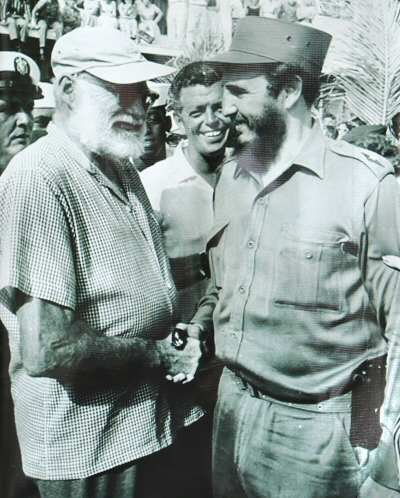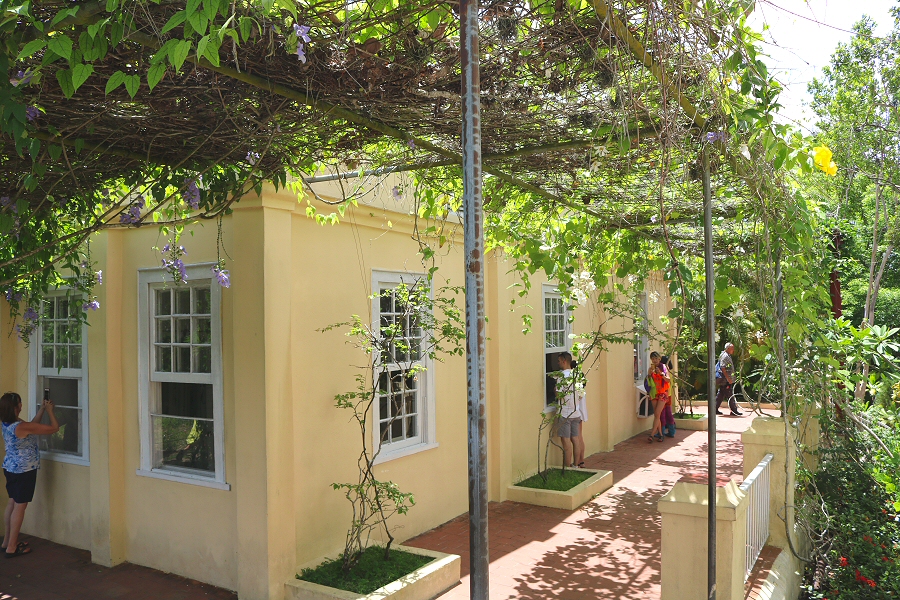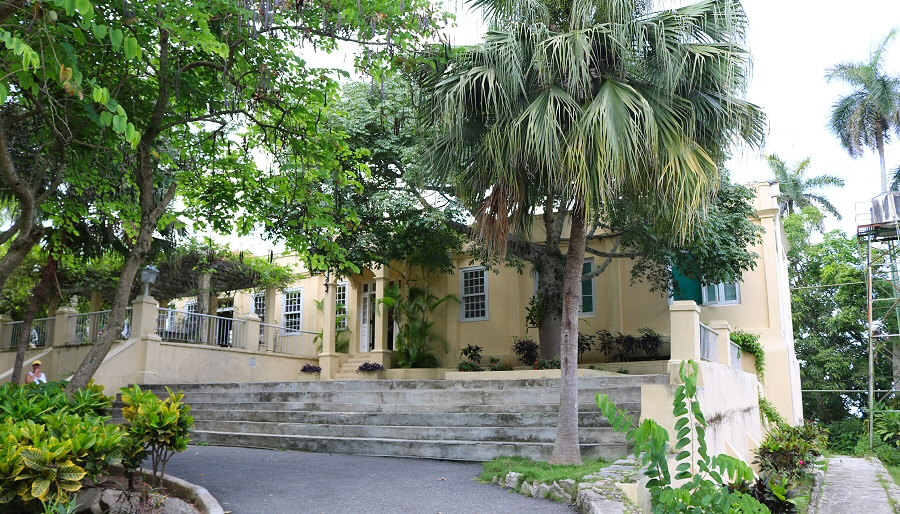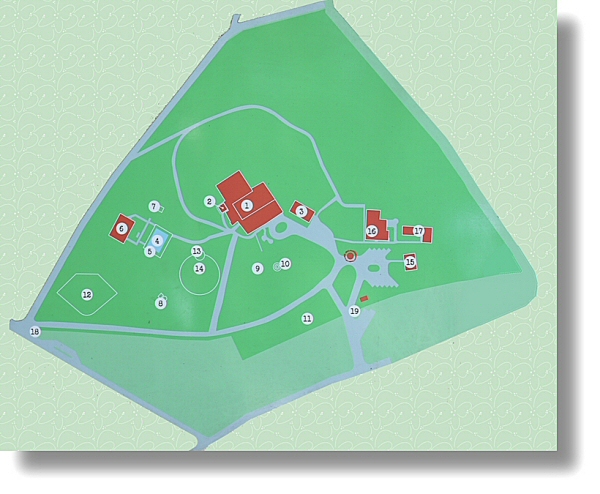

The farm La Vigía, or briefly Finca Vigía, is the farm in Havana where the renowned American writer Ernest Hemingway (1866-1961) lived from 1939 to 1960. In 1962, all the property was converted into a museum in honor of Hemingway's life and works. After years of disrepair, it is now restored and opened to public (since 2007).
Finca Vigía occupies an area on a hill, where a
surveillance post of the Spanish army was stationed until 19th
century, as the hill has an excellent view of downtown Havana.
The farm is named after this feature (Lookout Farm).
In 1886, the Catalan architect Miguel Pascual y Baguer that
had recently lost two of his children, bought the land to build
a house for his family. By this way, he wanted to forget the
pain, generated by the death of his children. In this farmhouse
he lived with his family until 1903. After this date, the
property passed into the hand of different owners.
Ernest Hemingway was staying in Hotel Ambos Mundos during
his visits to Havana. Martha Gellhorn, Hemingway’s third wife,
was tired of bar-hopping lifestyle of Hemingway and wanted to
move from the small hotel room (number 511) to a spacious
residence in the tranquil suburb of Havana. When she
discovered the ad about Finca Vigía in a Cuban newspaper, she
convinced Hemingway to leave the hotel room. Thus, Hemingway
first rented Finca Vigía in 1939, and bought it for 18.500 pesos
($12.500) in 1940. He used the first royalty of this book For
Whom the Bell Tolls, published in 1940, in purchase of Finca
Vigía.
After Hemingway divorced Gellhorn in 1945, he kept the
farm and lived there during the winters with his fourth and last
wife Mary Welsh, a former Time magazine correspondent. It was
Mary Welsh that converted the farmhouse to a splendid mansion by
furnishing it to her delight. The vibrant Cuban culture and the
clime at the farm made Hemingway to feel good in Havana. Thus,
Finca Vigía became his stable winter residence. He lived there
until one year prior his death in 1961.
When the rebels, headed by Fidel Castro, took power on the
island, overthrowing the Batista’s bloody regime, the relations
between the US and Cuba worsened considerably, and in 1960, the
US started to lay an embargo on Cuba. Hemingway left Cuba for
the last time in July 1960. Everybody is the same opinion that
Hemingway was fully intended to return to Cuba.
 Hemingway looked positively to the uprising on the island,
headed by Fidel Castro, expressing his thoughts by saying:” We
the Cubans are going to win”. When the new regime began in
Cuba:” I am very glad to be here...because I consider myself
Cuban…I sympathize with the government and all our
difficulties.” The new government replied to his sympathy by
holding the Ernest Hemingway International Billfishing
Tournament in 1960.
Hemingway looked positively to the uprising on the island,
headed by Fidel Castro, expressing his thoughts by saying:” We
the Cubans are going to win”. When the new regime began in
Cuba:” I am very glad to be here...because I consider myself
Cuban…I sympathize with the government and all our
difficulties.” The new government replied to his sympathy by
holding the Ernest Hemingway International Billfishing
Tournament in 1960.
After returning to the US from his trip to Spain,
Hemingway was worrying about staying in Cuba. He knew that one
day in the close future, he would be driven to leave the farm in
Havana and move to the US to live in his house in Ketchum. When
the US broke off diplomatic relations with Cuba, he had to cut
his ties with Cuba, as he was an American citizen and his
citizenship would be withdrawn, if he would continue to stay in
Havana. After the invasion in Playa Girón in 1961, the crisis
between the US and Cuba deepened. When Hemingway committed a
suicide in the US due to deep depression that he was suffering
since a long time, the Cuban government expropriated Fina Vigia,
along with all foreign properties in Cuba.
The same year, Hemingway’s widow Mary flied to Cuba and
held a meeting with Castro. As Mary Hemingway mentions in her
memoir, Castro personally came to the farm, toured the residence
and climbed the tower. Mary was successful in persuading Castro
to transport certain easily movable personal property of
Hemingway to the US. Thus, she took with what she could stuff
into the shrimp boat that she used in arriving in Havana. She
transported some paintings and a few books to the US, along with
his manuscripts that are now in the Kennedy Library, in Boston.
In 1962, the Cuban government converted Finca Vigía into a
museum, devoted to Ernest Hemingway, with all the property
“donated” by Mary Hemingway.
 The
house is preserved almost exactly as Hemingway left it, when he
departed from Cuba for the last time. Therefore, access into the
house is restricted to the visitors that can get only the
opportunity to peer in windows and doors.
The
house is preserved almost exactly as Hemingway left it, when he
departed from Cuba for the last time. Therefore, access into the
house is restricted to the visitors that can get only the
opportunity to peer in windows and doors.
Hemingway was a cat lover. His fondness for cats peaked at
Finca Vigía. The grey cat, named Princesa, was his first cat in
Finca Vigía and the number of his cats increased to 50, while he
was living there. Many different stories are told about
Hemingway’s cats; some true, some exaggerated, but everybody has
the same opinion that the cats were roaming freely in all the
rooms of the house. When Mary Hemingway moved into the farm in
1946, she constructed the tower for Hemingway, where he would
write his novels, but Hemingway preferred to work in the
bedroom, so that eventually the first floor of the tower became
the home for the cats parallel to the increase in their
population.
His favorite cat was a black and white tom, called Boise.
He devoted 35 pages to Boise in his novel Islands in the Stream.
Every cat had a name, like Good Will, Christobal, Feather Puss,
Zane Grey, Clark Gable, Uncle Wolfer, among others. It is argued
that it was in Cuba that Hemingway began to collect polydactyl
(multi-toed) cats, because, like the Cuban fishermen, he
believed that such cats would bring good luck. However, there is
no evidence that any of Hemingway's cats in Cuba was polydactyl.
Currently, there are no cats in Finca Vigía.
Besides the fifty cats in the farm, Ernest Hemingway had
also four dogs. His love for his pets can be seen today in the
manner that he interred them with gravestones in his garden. The
Black, Linda, Negrita and Neron shared the farm with the cats in
peace. Hemingway’s favorite was the Black that was shot by a
Batista’s soldier at the entrance of the farm, as the pet wanted
to stop him. Hemingway was very upset because of this tragic
event.
Hemingway was very productive in Finca Vigía. He wrote
much of his famous novel For Whom the Bell Tolls here, which he
started to write in Hotel Ambos Mundos. Here, Hemingway wrote
his masterwork The Old Man and the Sea (published in 1951) that
was awarded the Nobel Prize in Literature in 1954. He dedicated
this prize to the Cuban people. Across the River and Into the
Trees (published in 1950) is another work that he completed in
Finca Vigía. He started to write The Garden of Eden here in 1946
and worked on it until his death (published in 1986). Meanwhile,
he started to write Islands in the Stream around 1950 and almost
completed it in 1951 (published in 1977). Again, he started to
write A Movable Feast in 1920s and almost completed in Finca
Vigía (published in 1964).

Finca Vigía, is located in the
district of San Francisco de Paula, about 24 km east to the Old
Havana.
